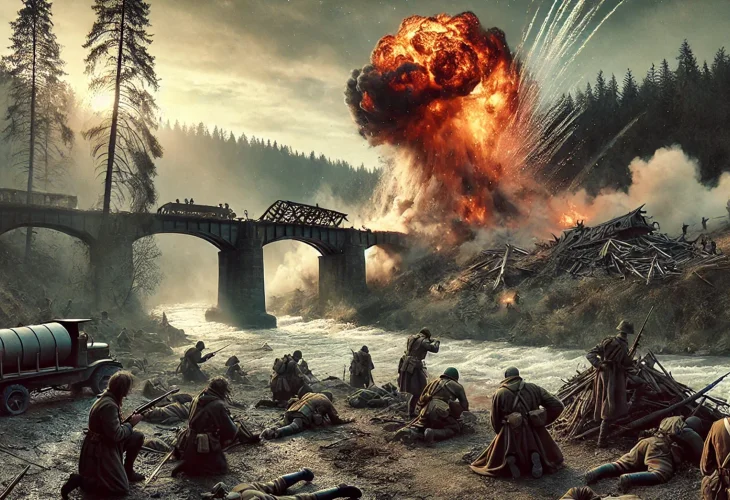The Fate of the Missing: The Haunting Tale of the Night of the Bridges Agunot
Despite the overall success of the operation and the destruction of 12 other bridges, the disaster was massive. Although the bridge exploded, many fighters fell. The blast was so large that most of the bodies could not be located or identified.

June 17, 1946. Forty Palmach fighters sombrely left Kibbutz Matzuva, near Shlomi, heading east. They covered 4.5 kilometers through the tree-covered hills toward the sea. Their destination was the A-Ziv Bridge, which carried the railway from Haifa to Tyre and crossed above the Ziv Stream. As they approached the final stretch, with the sea now visible ahead, they maintained absolute silence. To the south lay the hostile village of A-Ziv, now the Achziv Beach campground. Their mission: to blow up the railway bridge.
This decision by the Palmach was part of a larger offensive on the bridges around Israel. Just days earlier, Lord Bevin announced that His Majesty's Government was rescinding its decision to allow 100,000 Jews to enter Israel, claiming it would necessitate an entire additional division and a substantial security budget. In response, Yigal Alon devised a plan to disrupt British supply routes. If there were already budget issues, these would create real complications...
Thirteen key bridges were targeted for explosion, all used by the British to supply resources from neighboring countries: the Metula Bridge, carrying the road to Sidon and frequented by British supply trucks; the Bnot Ya’akov Bridge, facilitating eastward transport to Jordan; the Adam Bridge; the Allenby Bridge, and others. The task of the forty soldiers from the first battalion of the Palmach was to demolish the A-Ziv Bridge, halting the railway to Lebanon.
The plan had been on hold for some time, and approval was finally given on the 18th of the month under an almost full moon. This posed a disadvantage, as the fighters could be spotted, but the mission could not be canceled. Carefully, the forty fighters set out from Matzuva to the bridge.
At the Ziv Stream estuary, there were two bridges: one for trains and another for the road. The fighters were to reach the railway bridge, split, and another group would proceed to the road bridge. However, upon reaching the railway bridge, they were discovered by hostile villagers from the nearby settlement, leading to an exchange of fire. Suddenly, a huge explosion roared, sending a cloud of smoke skyward. A sniper's bullet had struck a bag storing the explosive charge. The bridge was shattered, but the fighting squad was severely hit. Fifteen fighters died on the spot.
Despite the overall success and the explosion of 12 other bridges, the disaster was immense. Though the bridge was destroyed, numerous fighters fell. The explosion was so massive that identifying or locating most of the bodies was impossible. The surviving fighters, fearing discovery, hid in a cave near Hanita. They, too, didn’t know the exact fate of the others. Months passed, the injured healed, the hidden emerged, but the fate of the fallen remained unknown. Rumors spread that some were captured by the Arabs and smuggled across the Jordan. A few remained missing. In a Haifa cemetery, the funeral of a soldier killed in this battle, whose body was identifiable, took place, and along with him, apparently, other remnants were buried. The newspapers reported: "14 individuals, among them, undoubtedly one wounded person and possibly more, are yet to arrive. It is assumed they are hiding nearby because they couldn’t make it," and in another paper: "The notion that this explosion could turn 13 people to dust leaving no trace or limb is inconceivable... Where are these 13 missing?... Accepting the dreadful assumption that the missing are no longer alive is untenable."
The situation was terrible for the families, but that period was marked by many casualties, amidst numerous harsh incidents. There wasn't much that could be done. Most of the fallen were unmarried, yet one was married. His name was Yaakov, and his wife waited at Rosh Hanikra for months, year after year. She remained an agunah.
The matter was referred to major rabbinic authorities of the era, including Rabbi Ben Tzion Chai Uziel, the Chief Rabbi, Rabbi Zvi Pesach Frank of Jerusalem, and the Chazon Ish from Bnei Brak. Rabbi Frank stated that Yaakov's wife could remarry, even though no remains of the bodies were found, as the sheer scale of the explosion nullified the presumption of marriage. All the more, the status of an agunah as married is only maintained when there's no clear knowledge of her husband being in a site of catastrophe. Just as agunot of those in concentration camps designated for annihilation could be freed, their presumption of life was tragically and horrendously nullified.
The Chazon Ish disagreed. He argued that, from a halachic perspective, there’s no definitive "was at the site of an explosion", given that out of forty fighters, twenty-five survived. Only those near the explosion died, and how can it be determined if he was close or not? As he is missing, this is merely conjecture.
Rabbi Frank, in response, meticulously sought out all media accounts describing the event and deduced there’s also an external authoritative determination that these individuals died beyond doubt. The Chazon Ish did not accept this.
Ultimately, the opinions of Chief Rabbi Uziel and Rabbi Frank prevailed, and the woman was permitted to remarry.
Only in 2001 was a mass grave discovered at the site, containing remnants of bodies. Three years later, after a thorough investigation, it was revealed that parts of the bodies from the event were also buried at Kibbutz Matzuva. In the aftermath of trauma and shock, this had not been properly reported. Following public pressure, the remains of all the fallen were returned to the explosion site, where a memorial was erected around this mass grave, in the very place they fell for the land of Israel.

